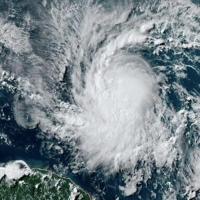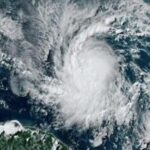Alerts were issued for much of the southeast Caribbean late Saturday as Beryl became the first hurricane of the 2024 Atlantic season, expected to rapidly intensify into a major storm according to forecasters.
The US National Hurricane Center (NHC) reported that Beryl, currently located about 595 miles east of Barbados in the Atlantic Ocean, is set to become a “dangerous major hurricane” by the time it reaches the Windward Islands late Sunday into Monday.
Hurricane warnings were in effect for Barbados, St Lucia, St Vincent and the Grenadines, and Grenada, while tropical storm warnings or watches were issued for Martinique, Tobago, and Dominica as per the NHC’s latest advisory.
In Bridgetown, Barbados, vehicles queued at gas stations while stores were packed with shoppers stocking up on supplies. Some residents started boarding up their homes in preparation.
A major hurricane is classified as a Category 3 or higher on the Saffir-Simpson scale, with winds exceeding 111 miles per hour.
Experts noted the rarity of such a powerful storm forming early in the Atlantic hurricane season, which typically spans from early June to late November.
“Only five major hurricanes of Category 3 or higher have been recorded in the Atlantic before the first week of July. Beryl would be the sixth and the earliest to form this far east in the tropical Atlantic,” shared hurricane expert Michael Lowry on social media platform X.
Saturday night reports from the NHC indicated that Beryl’s maximum sustained winds had strengthened to 85 mph with higher gusts.
Hurricane conditions are forecasted in the warning area starting Sunday night, with risks of heavy rain, flooding, and life-threatening winds and storm surge that could elevate water levels up to seven feet above normal.
The NHC cautioned about stronger winds on elevated areas, with wind speeds on hills and mountains potentially 30 percent higher than surface winds.
The Saffir-Simpson wind scale ranges from Category 1 hurricanes with wind speeds of at least 74 mph to Category 5 storms with speeds exceeding 157 mph.
The US National Oceanic and Atmospheric Administration predicted an “extraordinary” hurricane season with up to seven storms of Category 3 or higher, citing warm Atlantic ocean temperatures and La Nina conditions in the Pacific as contributing factors.
Climate change has led to an increase in extreme weather events, including hurricanes, causing more frequent and severe impact in recent years.
bur-st-mlm/rsc





